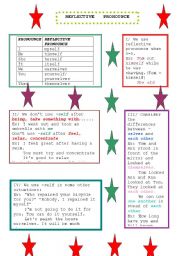
That sounds funny, right? It’s also not completely clear. But why? Why can’t you just use Lisa again? In order to say this, you need a reflexive pronoun. Maybe Lisa is learning English on her own, for example. Now let’s imagine that we want to say Lisa is the one who’s teaching, but Lisa is also the one being taught. We know that the students are who Lisa is teaching. Here, we don’t know who Lisa is teaching English to. (Download) So, What Are Reflexive Verbs?Īs we noted earlier, reflexive verbs are verbs that use reflexive pronouns.
#Meaning of reflective pronoun pdf
This blog post is available as a convenient and portable PDF that youĬlick here to get a copy. When You Don’t Need to Use Reflexive Pronouns.Other Ways Reflexive Pronouns Can Be Used.List of Common Verbs That Are Used with Reflexive Pronouns.All the Reflexive Pronouns You Need to Know.But what the heck does all of that mean?īy the end of this post, you will be able to congratulate yourself on your knowledge of English reflexive verbs and pronouns. A reflexive pronoun can be used in a few different ways, including in reflexive verbs. Maybe you grow your own vegetables, or are learning English by yourself. Print.By Michael Cristiano and Elisabeth Cook Last updated:Įnglish Reflexive Verbs and Pronouns: A Self-study Guide (The original text above is an example of this same principle being applied to excess.) Works Citedĭr. In short, the reflexive pronoun, when used in this way instead of the “proper usage” as explained above, directs the sentence’s emphasis and therefore the reader’s focus towards the noun to which the pronoun refers, indicating that it is in some way worthy of extra attention. The usage above, with the reflexive pronoun included, implies that there is something unusual or notable about that particular individual being involved. The Grinch himself carved the roast beast! Thus the reflexive is being used for emphasis only it is understood that this sentence: We can tell this is how it is being used because, as you can see, the object and the subject of the verb are very definitely not the same. Seuss, shows the reflexive pronoun in its use as emphasis. This sentence, from the popular children’s book How the Grinch Stole Christmas by Dr. A well-known example follows:Īnd he-he himself-the Grinch carved the roast beast! There is, however, one way in which the reflexive pronoun may be used that does not fit into that structure: It can be used to emphasize any noun or pronoun directly preceding it. Exceptionįollowing the rule stated at the top of this article will steer you right the vast majority of the time. In this case, the subject is second-person (“you”), and the object is first-person (“ myself”), so they can’t be referring to the same individual. The phrase “email myself” cannot be used in this context, because the only person who can “email myself”is “ I.” Remember, we only need the reflexive if the subject and the object of the verb are both the same. For instance:įreeing the pronoun from the detritus of the rest of the verb’s object makes the problem much clearer. A good way to determine whether you need to use the reflexive pronoun is to apply the same trick that is usually used to check whether your pronouns should be nominative or accusative break the sentence down. The meaning is the same either way, but the first is recognized as incorrect and should be avoided. Note that the reflexive pronoun has been replaced with the first person accusative pronoun. There is no need for a reflexive pronoun here, as the person doing the emailing (“you”) is not the same as the person being emailed. If you have questions, email Bob or myself. Though this does not necessarily impair meaning, it is considered incorrect.

Improper UsageĪ grammatical error that is somewhat common among developing writers is the use of reflexive pronouns when they are not needed, usually in an attempt to appear more formal.

Most English speakers would read this sentence as meaning Jane was shaking someone else, which suggests a different situation entirely.

However, if we were to replace the reflexive pronoun with the standard accusative pronoun “her,” the meaning changes: Jane was drifting to sleep at a time when she shouldn’t be, possibly during class, so she made a sudden movement in order to stay awake. The meaning of the sentence is fairly clear. If the object and the subject of a verb are the same, use a reflexive pronoun for the object. The following can be considered a rule with regards to reflexive pronouns: In English, these are the pronouns that end with “self” or “selves”: e.g., “himself,” “myself,” “ourselves,” etc.
#Meaning of reflective pronoun how to
This section has information about how to use pronouns correctly.Ī reflexive pronoun is a specific type of pronoun that is used for the object of a verb when it refers to the same noun as the subject of that verb. Writing Letters of Recommendation for Students.


 0 kommentar(er)
0 kommentar(er)
